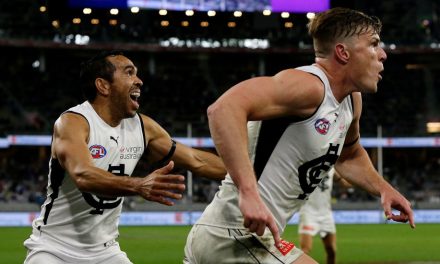Australia assembles for its team photo before the start of the last International Rules game against Ireland in Dublin two years ago. Photo: GETTY IMAGES
International Rules can work if AFL gets serious about it
You might not have realised it, indeed you would have to have scanned local media pretty closely to find any evidence, but on Sunday Australia will play Ireland in the first international rules match in almost two years.
International rules has seemingly become a non-event, the build-up this year almost non-existent.
It’s also become a frequent target of criticism from AFL fans, many showing little interest in or even disdain for the hybrid game.
But while the series has certainly experienced its ups and downs over the years, as long as the Australian side at least remains competitive, I believe it is a concept worth persisting with.
After the disaster of the 2011 and 2013 series – where three of the four matches were attended by less than 23,000 people and Australia was flogged by a combined aggregate of 166 points – the notion of a competitive Australian side seemed fanciful.
In response, the AFL tightened its selection criteria, allowing only players with All-Australian honours to play.
This has certainly improved the competitiveness, with Australia beating Ireland 56 to 46 in a one-off 2014 test in Perth, while they suffered a close four-point loss a year later in a one-off test held in Dublin.
Crowds also showed a marked improvement, with over 38,000 fans attending both these one-off fixtures.
The challenge to remain competitive and draw a crowd will be heightened this year, with the 2017 series consisting of two Tests for the first time since that ill-fated 2013 series.
Australia can be buoyed, though, by the fact this year’s squad remains loaded with All-Australian talent, although the AFL has softened selection criteria somewhat by allowing a number of players who have merely made the 40-man All-Australian squad.
While the inconsistency and at-times lack of commitment to the series has made it difficult for AFL supporters to become invested in the sport, the sheer amount of talent on display in the Australian team should be enough to pique the interest of even the most casual fan.
How else will you be able to see Patrick Dangerfield, Scott Pendlebury, Rory Sloane, Nat Fyfe, Joel Selwood and Eddie Betts competing on the same team?
The AFL will almost certainly never be able to field an All-Australian team in a World Cup tournament like Rugby League, while state-of-origin football looks to be consigned to the history books.
That leaves International Rules as the only truly representative occasion for AFL players to experience.
The players certainly still appreciate it, with Brendon Goddard saying last month that he felt great pride in pulling on an Australian guernsey and representing his country.
Australia’s International Rules coach Chris Scott has also defended the integrity of the series, and emphasised that the game was actually very exciting to watch.
“This is an opportunity we have to take our game internationally and even though it is different, it’s an exciting game,” Scott told SEN. “It’s really high intensity, it’s free-flowing, it’s attacking and we’re certainly going to play an attacking brand of footy. We’re going to risk getting scored against to try to score ourselves.
“If people take that approach, that it is something different, it’s close enough to AFL footy that the people who love our game could enjoy it but it’s different enough to see something we don’t get exposed to for 12 months a year.”
That is perhaps something that gets lost in the discussion around the merits of the series – the actual aesthetic quality of the product.
As Scott notes, it is a very exciting game to watch, most matches full of attacking flair and free-flowing play.
Yet the AFL has done a very poor job of promoting the series this year, and as such it is difficult to gauge how crowd figures will measure up for the First Test at Adelaide Oval on Sunday.
Media coverage has been in scarce supply, with mainstream outlets preferring to focus on where Rory Sloane will be playing in 18 months, or Jamie Elliott’s off-field discretions, rather than on an actual game taking place featuring a swag of AFL stars.
It seems logical in an off-season bereft of AFL action that the league, the media and fans would get around a concept that has helped to draw a greater international audience to our game.
But in order for this to happen, International Rules needs to rebuild its image by staging a competitive, highly-attended series this year.
The last two Tests proved that the concept still has a heartbeat. Another successful series may just guarantee the game’s future for the years to come.
And for a sport devoid of an international presence and representative matches, a thriving International Rules series is something the AFL community should absolutely welcome.











